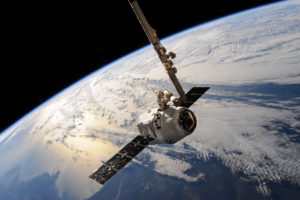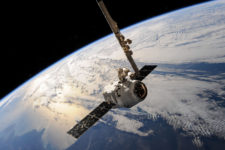What would it be like to have the ability to teleport?

I don’t know about you but hearing Captain Kirk (from Star Trek) utter “Beam me up, Scotty!” has always filled me with wonder. What would it be like to have the ability to teleport? Imagine being able to say goodbye to long airport lines, delayed flights and cramped airplanes. Or imagine spending the afternoon at your favorite café in Mars and being back home in time for dinner. Unfortunately, teleportation is still a Sci-Fi fantasy… or is it?
If you look at teleportation through the definition by David Darling, in his book “Teleportation – The Impossible Leap,” as turning an object or person into “bits” of information
and transferring it, this fantasy might very soon come to reality.
According to Erez Livneh, an Israeli scientist graduate of the Weizmann Institute of Science and CEO of biotech company Vecoy Nanomedicines, teleportation via what he calls “Bitportation” might be feasible with the resources and technology we already have.
How does Bitportation work?
Bitportation involves the conversion of an object into information by scanning it, the transmission of that information to a new location and the recreation of a physical entity by a manufacturing device such as a 3D printer.
Just like sending a fax, bitportation relies on multiplication. In other words, there will be two copies of the object, each on a different spatial place. Livneh described this teleporting process as “Copy & Paste” transportation which he contrasts to classical means of transportation that require leaving the starting point and traveling a specific distance to arrive at the destination, which we could refer to as “Cut & Paste” transportation.

The result of bitportation is hence two identical but independent entities at each end of the line.
Livneh argues bitportation is not only feasible, but it is also already here in an early form. We already have many of the resources due to technological innovations, we just need to develop the capabilities.
The impact of this innovative idea goes well beyond our earth…

Traveling through space, as we know it today, involves special spacecraft that travel long distances for extended periods of time. Although traveling to the moon could take as little as 3-4 days, traveling to Mars requires a journey of approximately 300 days. This makes it currently very difficult to send a manned expedition anywhere beyond the moon and definitely beyond our solar system.
Since space travel assumes there is a person onboard a spacecraft and there is so much acceleration a person and spacecraft can take, travel speeds have to be slow. Traveling at the speed of light, which is the maximal speed in the universe based on Relativity Physics, is out of the
In a report to NASA, Livneh envisions five stages, which he calls the “RESTORE protocol”: Reach, Establish, Scan & Design, Transmit Object, REmaterialize.
The first step, Reach, involves dispatching an unmanned spacecraft into space towards a planet or asteroid. This spacecraft could be remotely guided or could have the ability to navigate autonomously through artificial intelligence (AI). Once it arrives at its destination, it will split to deploy a communication orbiter and a manufacturing unit on the ground, therefore establishing the teleporting capability, the second step.
The next step, Scan & Design, will be performed on Earth and it will entail capturing the physical aspects of the object to be teleported. Remember the scanning done by the fax?
The fourth step, Transmit, involves transmitting the 3D model data by space communication signal to the remote communication orbiter deployed on stage one. The orbiter will, in turn, transmit the data received to the manufacturer lander.
The last step is to Rematerialize. In this step, the data transmitted will be utilized to manufacture a copy of the object teleported to space with the help of physical, biological or nano-assembler capabilities. This is one of the most innovative aspects of bitportation.
Livneh shared that physical “rematerialization” is more feasible than ever before thanks to a company called Made in Space. This start-up, based in the US, has developed a 3D printer capable of working in zero-gravity, with which they have been printing parts in the International Space Station since the end of 2014.
What about the teleportation of humans?
Since we currently have the technology to scan our bodies (think about the range of available diagnostic tools, anything from an X-ray to a sophisticated CAT scan), a human could also, in theory, be scanned and teleported. However, teleporting people is still tricky. We are delicate and complex creatures. It is one thing to transport inanimate matter and another to capture and remake the exact complex structure of atoms that make us who we are.
Since bitportation involves multiplication, the bitportation of humans is essentially human cloning. In addition to the very difficult technological practicalities, cloning brings up a slew of philosophical, theological and moral considerations that will make human bitportation a complicated affair.
The essential question is this: Is the identical clone really identical or just a soulless body? Aside from rematerializing the human body, a shell of sorts, can we also bitportate what makes us who we are? What about our memories, thoughts, and feelings? If these are mere structures in our central neural system, then scanning them precisely will deliver them along with the cloned bodies.

Although this is still a big unknown, several experiments in this area have taken place in the last decade. Neuroscientists were able to “extract” memories using a sophisticated MRI, trace how memories are encoded in the brain, reconstruct movie clips that people watched, determine which of two images were stored in someone’s memory, and in the most promising study yet, scientists at the University of Oregon have invented a machine that can “extract” thoughts. We are closer to sophisticated mind reading than ever before. So, we could one day have the ability to scan our personality along with our body and turn it into “transportable” data, and this day is maybe not too far.
Should you start packing?
Once we have the technology to scan our bodies and our personality, the big question remains: What will happen on the other side? A very sophisticated machine will be needed to rematerialize a human being and safely create a perfect clone, one that has both our body and our identity. Safely teleporting people will only be feasible once complex rematerialization technology is available, one that has atomic-scale precision, and we are still rather far from it. So, you may take your time packing.
If you really think about it, teleportation is one of those innovations that can change everything! I can’t wait. Can you?
Want to read more? Learn about our very own expat’s experiences in Shanghai.
